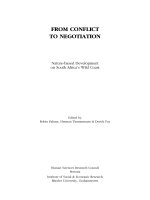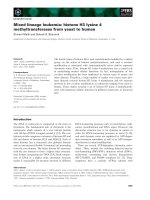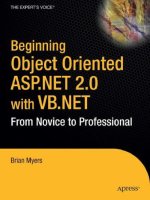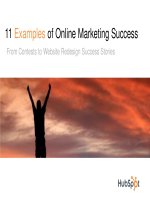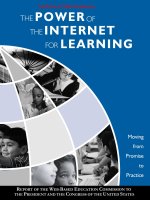From success to Significance pptx
Bạn đang xem bản rút gọn của tài liệu. Xem và tải ngay bản đầy đủ của tài liệu tại đây (1.29 MB, 211 trang )
031020755X_relation_fm.qxp 9/8/06 2:21 PM Page 1
This page is intentionally left blank
$UCCESS
SIGNIFICANCE
From
To
031025356x_sucsesig.qxp 3/3/08 2:20 PM Page 1
031020755X_relation_fm.qxp 9/8/06 2:21 PM Page 1
This page is intentionally left blank
$UCCESS
SIGNIFICANCE
From
To
When the Pursuit of Success Isn’t Enough
Lloyd Reeb
031025356x_sucsesig.qxp 3/3/08 2:22 PM Page 3
From Success to Significance
Copyright © 2004 by Lloyd Reeb
Requests for information should be addressed to:
Zondervan, Grand Rapids, Michigan 49530
Library of Congress Cataloging-in-Publication Data
Reeb, Lloyd.
From success to significance: when the pursuit of success isn’t enough /
Lloyd Reeb.
p. cm.
ISBN-13: 978-0-310-25356-3 (hardcover)
ISBN-10: 0-310-25356-X (hardcover)
1. Middle aged persons—Religious life. 2. Middle aged persons—Psychology.
3. Self-realization—Religious aspects—Christianity. I. Title.
BV4579.5.R44 2004
248.8'4—dc22
2004011984
All Scripture quotations, unless otherwise indicated, are taken from the Holy Bible: New
International Version®. NIV®. Copyright © 1973, 1978, 1984 by International Bible Society.
Used by permission of Zondervan. All rights reserved.
The website addresses recommended throughout this book are offered as a resource to
you. These websites are not intended in any way to be or imply an endorsement on the part
of Zondervan, nor do we vouch for their content for the life of this book.
All rights reserved. No part of this publication may be reproduced, stored in a retrieval sys-
tem, or transmitted in any form or by any means—electronic, mechanical, photocopy, record-
ing, or any other—except for brief quotations in printed reviews, without the prior permission
of the publisher.
08091011121314•26252423222120191817161514131211109
031025356x_sucsesig.qxp 3/6/08 7:38 AM Page 4
AER Edition January 2009 ISBN: 978-0-310-31782-1
All rights reserved under International and Pan-American Copyright Conventions. By
payment of the required fees, you have been granted the non-exclusive, non-transferable
right to access and read the text of this e-book on-screen. No part of this text may be
reproduced, transmitted, down loaded, decompiled, reverse engineered, or stored in or
introduced into any information storage and retrieval system, in any form or by any means,
whether electronic or mechanical, now known or hereinafter invented, without the express
written permission of Zondervan.
I would like to express my deepest appreciation to my
friend and mentor Bob Buford, the author of Halftime,
whose authentic, sacrificial life, and deep love for Jesus
Christ has inspired me and thousands of other successful
leaders at midlife to pursue eternal significance in our sec-
ond half.
Thanks to Linda, my beautiful wife, who for more
than twenty-five years has lived out for me what it really
means to follow Christ in everyday life.
031025356x_sucsesig.qxp 3/3/08 2:22 PM Page 5
031020755X_relation_fm.qxp 9/8/06 2:21 PM Page 1
This page is intentionally left blank
Contents
Foreword by Bob Buford 9
Introduction 13
PART I: FINDING THE FREEDOM TO DREAM AT MIDLIFE
Chapter 1: My Two-Minute Warning: 19
A Life-Defining Moment
Chapter 2: Redefining Success— 29
from a First-Quarter Perspective
Chapter 3: Like Punting into the Wind 37
Chapter 4: Halftime as Seen from 55
the Goodyear Blimp
Chapter 5: Finding Your Wellspring of Success 65
PART II: MOVING FROM DREAMS TO ACTION
Chapter 6: The Second Quarter: Pursuing 77
Success with Significance in Mind
Chapter 7: Creating a Playbook 83
Chapter 8: A Ten-Step Halftime Plan 89
Chapter 9: Pacing the Game: The Margin Dilemma 99
031025356x_sucsesig.qxp 3/3/08 2:20 PM Page 7
Chapter 10: Cutting What Is Least Valuable 105
Chapter 11: Overlapping What Is Most Valuable 109
Chapter 12: You Are a Free Agent— 115
and It’s Legal to Negotiate
Chapter 13: Where Is the Financial End Zone? 119
Chapter 14: Experimenting with Different 123
Plays and Positions
Chapter 15: Finding the Right Stadium 131
Chapter 16: Finding Your Spot on the Team 141
PART III: IMPORTANT MIDLIFE ISSUES I NEVER DREAMED OF
Chapter 17: A Completely Quiet Locker Room: 153
Doing It Alone, the Wrong Way
Chapter 18: Doing Halftime with Others 163
Chapter 19: Tackled from Behind by the Culture Gap 175
Chapter 20: Reengineering Your Niche 183
in the Second Half
Chapter 21: Discovering That Significance 191
Was Not Enough
Notes 195
About the Publisher 208
Share Your Thoughts 209
031025356x_sucsesig.qxp 3/3/08 2:20 PM Page 8
Foreword by Bob Buford
L
et me begin by confessing the intent of this foreword right up
front. My hope for Lloyd Reeb’s book, which you now hold,
is that it will convince you of two things—the first is that the
change-of-life season described as Halftime is nearly universal in
the developed world and critical to Halftimers. The second is
that the transition from success to significance as a central
motive force in life’s second half is not at all dependent upon
income and net worth.
Lloyd has captured ideas and illustrations that will enable
almost everyone who desires it to engage their passions in a life
of significance. This can be done either alongside their primary
work life in a parallel career, or as a primary career of work,
serving others in which money making takes a necessary but
subordinate role.
As the author of the book Halftime, I told my own particu-
lar and unique story, which happens to be that of a multimil-
lionaire, and the question always comes up: “Is Halftime a rich,
white, male thing?” This question seems to float in the air in
conversations at the Halftime Workshops that Lloyd and I have
done around the United States.
The answer is “No, it’s not,” but that always takes some expla-
nation. Mine is a story of having the good fortune of beginning in
the right business (television broadcasting, then cable television)
at the right time (the sixties to the nineties), in the right place (the
US). It is an example of one Halftime opportunity in the twentieth-
first century. But my story is only one of millions (yes, millions!).
The Halftime stories are many and diverse—as diverse as people
can be in an individualistic time and place like ours.
The great creation of the nineteenth and especially the twen-
tieth century has been the middle class. That’s my story and that
9
031025356x_sucsesig.qxp 3/3/08 2:20 PM Page 9
is Lloyd’s story too. The main difference is that my story of suc-
cessful commercial activity runs about twenty years of steady
and fairly intense compounding longer than his. I’m sixty-four.
Lloyd is forty-two. He was and still is in a different form of busi-
ness than I (senior-focused real estate), and he caught on to the
parallel-career idea sooner that I did. But his story shows the
path from success to significance just as clearly as mine does.
That’s why I encouraged him to write this book. That plus the
fact that there’s probably nobody else who has sat across from
more Halftimers than Lloyd, and his story at his age is more
representative of forty-something stories than mine now is.
Now let me make one more point. There’s a burgeoning new
field of research and writing that shows conclusively that there
is no connection between money and happiness. None! Not pos-
itive or negative. Zero! A terrific new book, The Progress Para-
dox (2003), rolls up most of the prior research and is currently
making its way up the bestseller lists. It, among others, contains
these three assertions, which I quote:
1. [There is a] “revolution of satisfied expecta-
tions,” the uneasy feeling that accompanies actu-
ally receiving the things that you dreamed of.
2. That society is undergoing a fundamental shift
from “material want” to “meaning want,” with
ever larger numbers of people reasonably secure
in terms of living standards, but feeling they lack
significance in their lives. A transition from
“material want” to “meaning want” is not a pre-
diction that men and women will cease being
materialistic; no social indicator points to such a
possibility. It is a prediction that ever more mil-
lions will expect both pleasant living standards
and a broad sense that their lives possess purpose.
This is a conundrum, as meaning is much more
difficult to acquire than material possessions.
From SUCCESS To SIGNIFICANCE
10
031025356x_sucsesig.qxp 3/3/08 2:20 PM Page 10
3. That new psychological research, which seeks to
explain why some are happy and others not, sug-
gests it is in your self-interest to be forgiving,
grateful, and optimistic—that these presump-
tively altruistic qualities are actually “essential to
personal well-being.”
1
Significance is an existential need, not an economic need.
Summing up the field: Nearly all well-being research supports
the basic conclusion that money and material needs are only
weakly associated with leading a good life. The magic number
at which money decouples from happiness is far less than you
might think. In fact some research suggests it may be as low as
about $40,000 for a family of four.
My basic logic and Lloyd’s too, as you will discover as you
read his account, goes like this: Why trade that which you can’t
acquire enough of (significance) for that which you have plenty
of already (success)? All of us will face a final exam when we
arrive at Heaven’s Gate for the beginning of our new life. As I
visualize it, there will be two questions: (1) “What did you do
about Jesus?” and (2) “What did you do with what I gave you
to work with?”
The book you are about to read is like getting the right
answers before the exam. A pretty good deal.
And not a moment too soon.
Bob Buford
Author, Halftime: Changing Your
Game Plan from Success to Significance
Founder, Leadership Network
www.halftime.org
Foreword
11
031025356x_sucsesig.qxp 3/3/08 2:20 PM Page 11
031020755X_relation_fm.qxp 9/8/06 2:21 PM Page 1
This page is intentionally left blank
Introduction
T
en years ago I made a midlife decision to reorient my life
toward significance. Now I no longer have that sick feeling in
my stomach of being trapped in a life of busyness, pursuing
things that won’t last at the expense of things I value most.
Strangely, though I work just as hard as ever, I feel little stress,
especially when compared to the gut-wrenching stress I experi-
enced as a real estate developer in the first half of my life. I’m
free of the rat race.
I remember those sleepless nights, rolling around in bed,
wondering if the bank would fund my next deal and whether
demand for my seniors’ housing project would be as strong as
I predicted. I remember the anxiety of thinking I was wasting
my life chasing illusions, secretly asking myself if this is what I
was created to do.
Sure, I still worry from time to time—when the stock mar-
kets fluctuate or unexpected family expenses emerge. But it’s a
different kind of worry. I still enjoy working hard, reaching
goals, and taking risks; but today I do it out of a sense of call-
ing rather than some unexplained inner drivenness. I do it with
the confidence that I’m in the “sweet spot” of what I was cre-
ated to do. And I’m having the time of my life. I wake up every
morning feeling lucky to know what I’m passionate about. I
know the things I’m good at, and I’ve been given the gift of
being able to focus my life on them.
I made that “Halftime” transition in 1993. I pushed the
pause button in the middle of the game of life so that I might
look back on the lessons and accomplishments of the first half,
to reflect on what will really matter in the long run, and then to
redirect my life in the second half. Specifically, I wanted to pur-
sue the possibility of moving from success to significance. But
13
031025356x_sucsesig.qxp 3/3/08 2:20 PM Page 13
without millions of dollars in the bank, I knew it would take
creativity and intention to discover how to pursue significance.
How I made this transition, mistakes and all, is the subject
of this book. Hundreds of thousands of people have read Bob
Buford’s book Halftime and felt touched with a longing for the
kind of significance he describes there. But many readers—reg-
ular, everyday people like you and I—have said, “That’s great
for Bob, but how can I do that without being wealthy?”
When I first met Bob, I described my own difficult transi-
tion. Without hesitation he looked me in the eyes and said, “Just
maybe God pulled you through that knothole so that you could
invest your life in helping others avoid it.” And that is what I am
dedicating my life to now.
Each day, between ten and twelve thousand people in the
United States turn fifty. One in four Americans are over fifty,
and the fifty-to-sixty-four-year-old age group is expected to
grow by 50 percent by 2015, making the mature consumer mar-
ket one that demands attention. But how many of those people
focus on their longing for significance?
Of the millions entering midlife, a growing number are
charting a Halftime course, choosing to swim upstream in our
culture, away from the temporary toward the eternal, simplify-
ing their lives so they can focus on the things that really matter.
This book recounts my own life story as well as the experiences
and insights of others who have also made this journey. This
book will ask tough questions and point you to resources that
will enable you to redefine success and pursue significance—
and chart a new course for your second half.
I didn’t sell my business or quit my job. Instead, I redefined
success, reallocated my energies, and re-prioritized my family’s
spending. I cut the time I spent doing business, found a niche as
one of the pastors at a large church in Charlotte, North Car-
olina, and help high-capacity business people find their second-
half calling. As a result, my wife, Linda, and I have had more
time over the past decade to spend with our three kids as they
grow, time to spend together playing tennis and sailing. I have
From SUCCESS To SIGNIFICANCE
14
031025356x_sucsesig.qxp 3/3/08 2:20 PM Page 14
enjoyed getting back into good physical shape and building a
few close friendships. By allocating part of my week to ministry,
I’ve had the thrill of being a part of many men’s and women’s
spiritual journeys as they pursue God and explore their personal
faith, and I have traveled around the world on mission trips. I
feel blessed to have had the freedom to invest a good part of my
life in things that I believe have eternal significance.
Do you know the most interesting thing about all this? What
makes all this possible is not that I’m rich, smart, or lucky. What
makes my life today so different from the lives of typical forty-
something executives has been choices, not chance. It’s about
options, not affluence; about availability more than ability. I’m
not downplaying the thrill or value of success. Instead, I’m rec-
ommending that you build on the success of your first half of
life and transform it into significance.
At times I wanted to forget all about making a difference
and simply go back to making money. I knew how to do it, and
I could measure my effectiveness in dollars and cents. At times
I was angry at the apparent lack of urgency within the nonprofit
organizations I was trying to help. After all, intensity and
urgency were keys to my success in real estate development—
and that was done strictly for the money. So, since this new
work was all about helping people, changing their lives and per-
haps even their eternal destinies, why did these nonprofit organ-
izations seem so unfocused? Why did they seem to have far less
urgency than my partner and I had in our business? Why did
some of the staff saunter out of the office at 4:30 p.m.?
But I soon realized that part of the burden was with me. I
hadn’t yet learned how to measure effectiveness in the nonprofit
arena of helping others.
Yet, despite all this, I would never want to return to my old
life, to the time before my midlife transition when I pursued suc-
cess with little regard for eternal significance.
Introduction
15
031025356x_sucsesig.qxp 3/3/08 2:20 PM Page 15
031020755X_relation_fm.qxp 9/8/06 2:21 PM Page 1
This page is intentionally left blank
PART I
FINDING THE FREEDOM
TO DREAM AT MIDLIFE
031025356x_sucsesig.qxp 3/3/08 2:20 PM Page 17
031020755X_relation_fm.qxp 9/8/06 2:21 PM Page 1
This page is intentionally left blank
My Two-Minute Warning:
A Life-Defining Moment
T
he shadows casting down the brick wall created the warmth
and richness of a building that I felt sure seniors would love
to call home for many years to come. The Georgian-style build-
ing overlooked a beautiful bend in the Tay River and incorpo-
rated all the conveniences of comfortable, modern living. We
named it Huntington Green. It was our most beautiful housing
development to date, and it represented the culmination of
months of intense planning and work.
Like a sculptor, I stood back and reflected on this finished
work, which had once been nothing more than a vision in my
mind. It was ribbon-cutting day, but for me it was so much
more. It was the confirmation I needed that I should invest my
life in something more significant than simply creating beauti-
ful buildings and making money.
I had just returned from five weeks in Albania, where I not
only saw poverty and despair everywhere I looked but had the
opportunity to work side-by-side with people who brought hope
and help to this country in turmoil. With the fall of many com-
munist governments in Eastern Europe in the early 1990s, Alba-
nia remained the most staunchly communist country in the
world, as well as the most isolated. The country’s communist
experiment had left it impoverished. Its three million people
depended on ancient farming methods, resulting in a tragically
inefficient agricultural industry that was unable to compete in a
global economy. After decades of centrally planned farming, the
Albanian farmers had no idea how to plan their own crops,
assess costs, set prices, or market their product.
Chapter 1
19
031025356x_sucsesig.qxp 3/3/08 2:20 PM Page 19
Finally, the old regime fell. Within months, the new Alban-
ian government recognized the critical importance of retraining
the country’s farmers. Creative, entrepreneurial leaders with
SEND International, a nonprofit missionary agency, rose to the
challenge and offered to send dozens of successful American and
Canadian farmers to Albania, to volunteer their time to help
Albanian farmers one-on-one. SEND International asked me to
lead the project.
I felt underequipped to lead such a project. After all, I didn’t
even know where Albania was, and I knew nothing about farm-
ing. But I did know that my leadership skills had proven them-
selves in the marketplace and that I desperately wanted to find
an avenue to make my life count for something more than mak-
ing money—to be a part of something bigger than myself.
So, at the invitation of the Albanian government, we took
more than seventy farmers to teach the Albanians the basics of
farming in a market economy. As they hung out together over
two weeks, the Albanians wanted to learn more about our West-
ern farms, our families, and even our faith in God. For me, this
project was a first step toward answering the deep longing of
my heart for significance.
Each team spent two weeks in their assigned village, work-
ing with every farmer that showed any receptivity. They lived in
the farmers’ homes—cement-block houses crowded together
along mud roads, with no phones and animals everywhere.
Farmland surrounded each village, and each morning the farm-
ers walked out to their fields carrying their rustic tools with
them. They did most of their work by hand. Their homes were
cold and dirty, with no indoor plumbing. The typical Albanian
farmer owned just a handful of acres, a few chickens, and a cow.
Our Canadian and American farmers, by contrast, owned
hundreds of acres and had huge tractors, trucks, and harvest-
ing equipment—and yet they humbly built a bridge of trust with
each Albanian family, opening the door to deeper conversation.
Often their discussion moved beyond farming to family, poli-
tics, and even spiritual topics.
Part I: Finding the Freedom to Dream at Midlife
20
031025356x_sucsesig.qxp 3/3/08 2:20 PM Page 20
The Albanians’ hearts overflowed with spiritual questions.
After all, for more than seventy years they had been told that
God did not exist. But even as they looked around at the beauty
and complexity of nature, they questioned that idea.
I will never forget how this experience affected one sixty-
year-old hog farmer from Tennessee, named Burress Nichols, as
well as a fifty-year-old turkey farmer from Vancouver, named
Ron Heppel. These busy, successful farmers had paid their own
way to Albania to give two weeks of their time. Even while they
recovered from jet lag and culture shock, they worked day and
night to help dozens of farmers rethink their farming strategies.
They slept on old, musty beds, used smelly outhouses—and, at
the end of their time, openly cried as they gave their host fami-
lies good-bye hugs. The entire village came out to say farewell.
Burress and Ron had fallen in love with these people and felt
awed by the real help and hope they were able to bring.
Burress and Ron had everything in life: loving families, the
latest farm equipment, large homes, nice cars, respect in their
communities, deep relationships with God—and yet they cried
as they left. Why? What had touched their hearts so deeply?
How is it possible that all of us had had such a rewarding expe-
rience in such an awful place?
Those questions were in the back of my mind as I prepared
to join the ribbon-cutting ceremony for our new building. Every-
one was there: the mayor and local media, contractors and new
residents. The contrast between the two worlds was all too clear
to me.
The bright yellow ribbon stretched between the main pillars
of the entrance, and cameras captured the moment. Ribbon cut-
tings always feel like a birth and graduation all rolled into one.
It’s the beginning of something and the end at the same time. As
my partner and I stood in front of the last building we would
ever build together—our most beautiful and profitable real
estate development ever—I sensed that a new birth was taking
place in my life. Even as I spoke to the group, my thoughts wan-
dered and I felt a stirring in my heart. Recently I watched a
Chapter 1: My Two-Minute Warning: A Life-Defining Moment
21
031025356x_sucsesig.qxp 3/3/08 2:20 PM Page 21
videotape of that event, filmed by a local TV station, and from
that perspective, nothing spectacular seemed to be going on. But
for me, it was a defining moment.
In the language of the National Football League, this was
my two-minute warning. Just before halftime, officials stop the
game to make sure that both sides know that two minutes
remain before the halftime break. I thought of this as one of the
kairos moments in my life (the Greek word kairos means “the
right, proper, or favorable time”), and I knew a new phase of
life was appearing on the horizon in my life and the life of my
family.
As I stood at the ribbon cutting, I felt I could almost hear the
bulldozers one hundred years from now pushing the building
into a great pile to make way for something new, something to
replace what we had worked so hard to create. I felt that within
a hundred years this building would either be torn down or
become a rundown tenement in a “bad section of town.” Did I
want to invest my entire life in developing buildings that would
only be torn down?
You too may have your own kairos moment, perhaps when
you realize you are spending too many precious hours in meet-
ings, or perhaps when you’ve tackled yet another urgent project,
only to have it canceled or altered because of a merger. Perhaps
you spend your time solving major issues, which, in the long
run, are relatively insignificant.
This morning, at a coffee shop, my friend Rob told me that
he could easily continue growing his company at exponential
rates, but he also knows in the end it will be just like Monop-
oly: “All the pieces go back in the box.” Many of us spend much
of our time driving the next quarter’s earnings, even while our
potential impact on eternity slips past us on all sides.
At the ribbon-cutting ceremony, my mind kept flashing back
to Albania, to the farm families in those remote villages; to the old
ladies with wrinkled faces and eyes filled with despair; to the teens
whose hopes and dreams seemed so unlikely because of the
wretched economy; to the fathers who felt the heavy burden of
Part I: Finding the Freedom to Dream at Midlife
22
031025356x_sucsesig.qxp 3/3/08 2:20 PM Page 22
providing for their families’ needs and safety when ethnic war
seemed inevitable. I thought about the hope we were able to bring
them, not just for farming, but also for eternity. We brought them
the wonderful story of a loving God who sends people to serve
them when they are in need and who offers forgiveness to all.
Many of them felt it was like offering cool water to a friend in the
heat of the summer on a dry and dusty road.
It dawned on me that, if this whole Christian thing is real
and true, then in one hundred years, when our buildings are get-
ting torn down, those farmers will just be starting to enjoy what
God has in store for them for an eternity in heaven. Eternity is
a very long time, and the impact we have on someone’s eternity
seems to overpower even the most noble benefits we can bring
them in the seventy some years they live on this earth.
But wait, my mind argued, these seniors’ buildings are about
serving people too. These developments contribute to society.
They provide a platform for us to share our faith among people
who are late in life. Aren’t we living out the Christ-life to the
degree that we can reflect Jesus in our interactions with con-
tractors and residents, architects and bankers?
Valid points. Of course, I knew I could be doing a much bet-
ter job than I was at reflecting the character of God through my
business. But even if I reached some pinnacle of witness in the
marketplace, I still felt a sense of loss to invest such a high per-
centage of my time and leadership ability in something that
eventually would cease to exist.
Several questions turned over in my mind:
• Is there more to life than just this?
• Is being an ethical leader in the marketplace enough?
• Could I really make a significant difference in people’s
lives by taking an active role in service to others, or
should I focus on making money and giving financially
to support the work of others?
• Given all the obligations in my life, such as my marriage,
family, work, and maintaining our chosen lifestyle, how
Chapter 1: My Two-Minute Warning: A Life-Defining Moment
23
031025356x_sucsesig.qxp 3/3/08 2:20 PM Page 23

